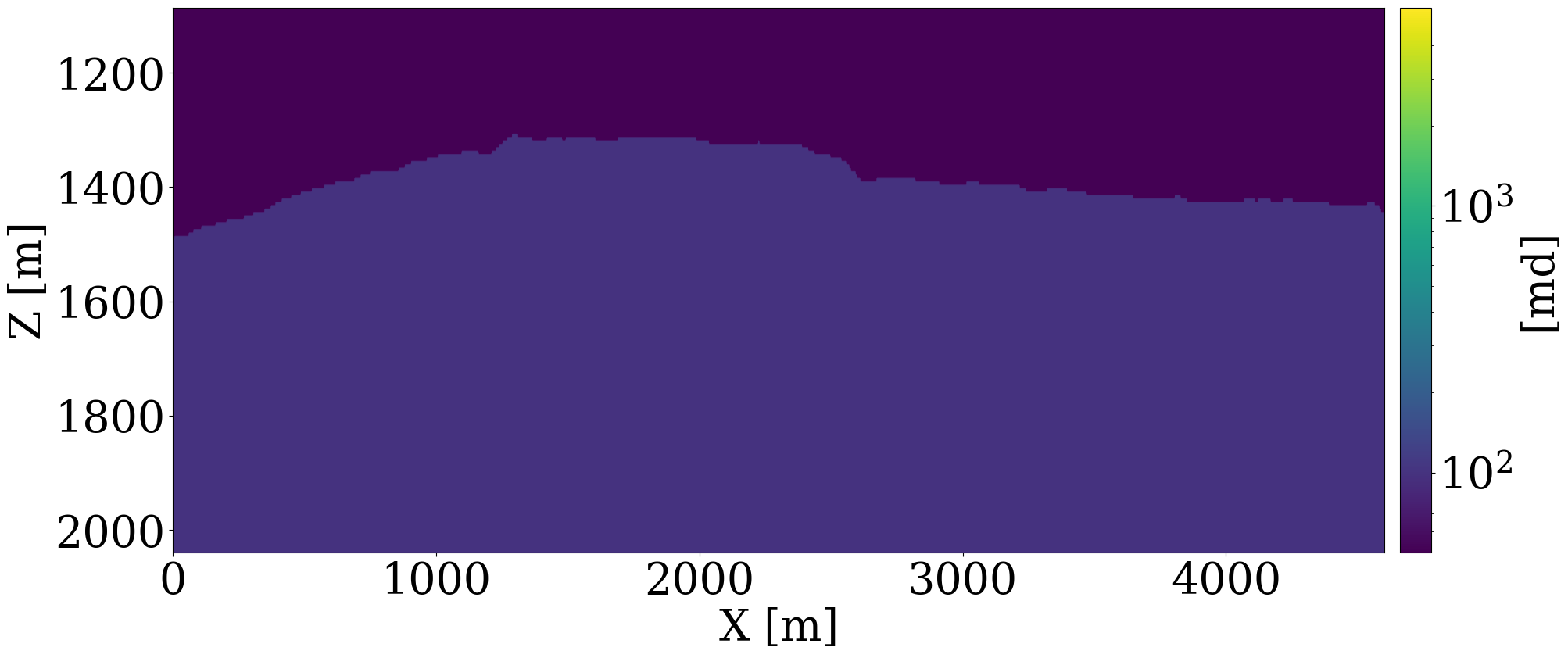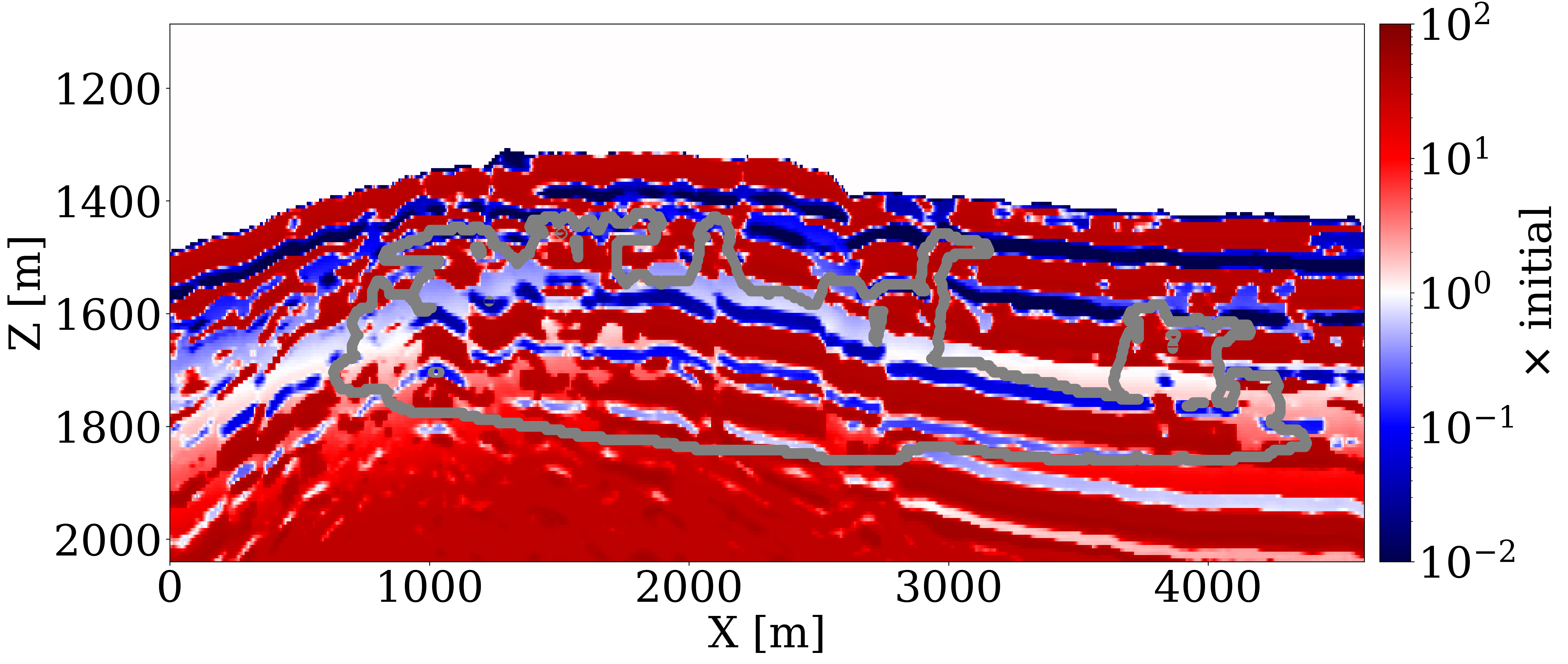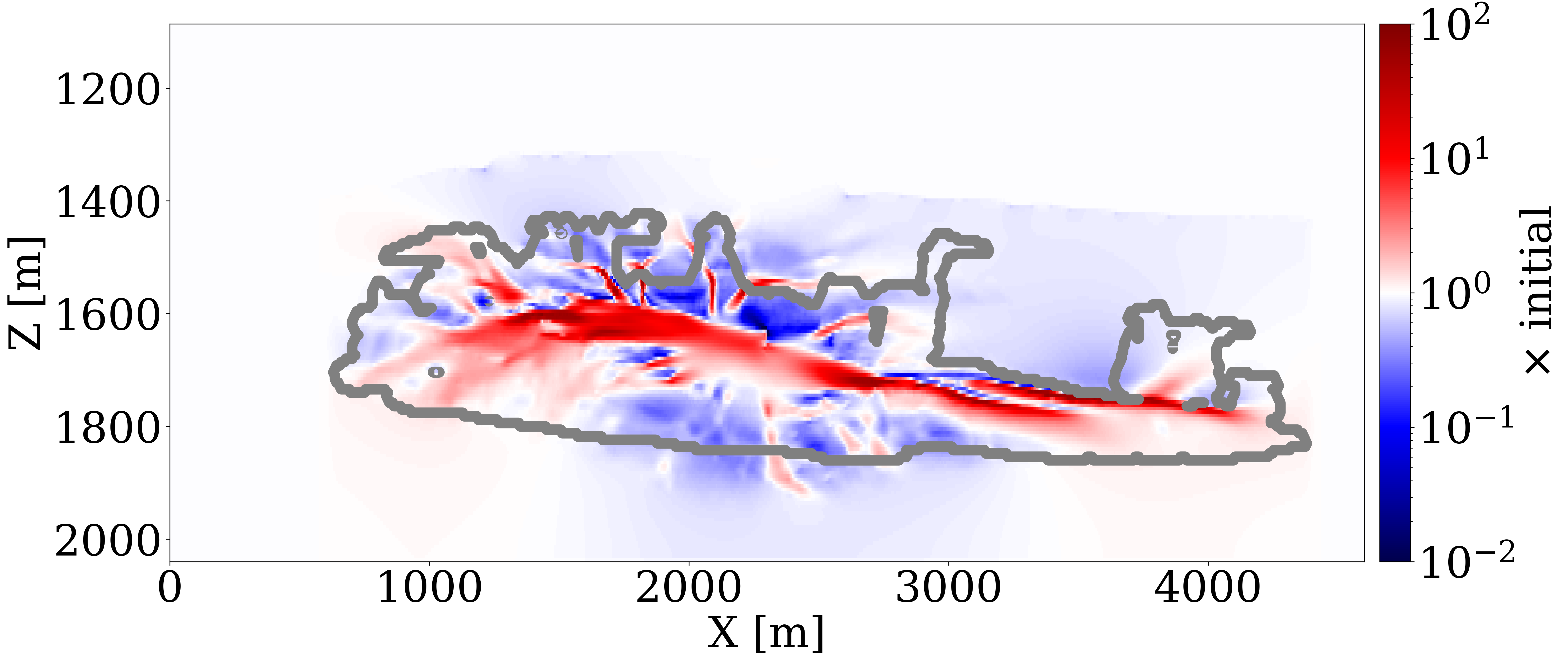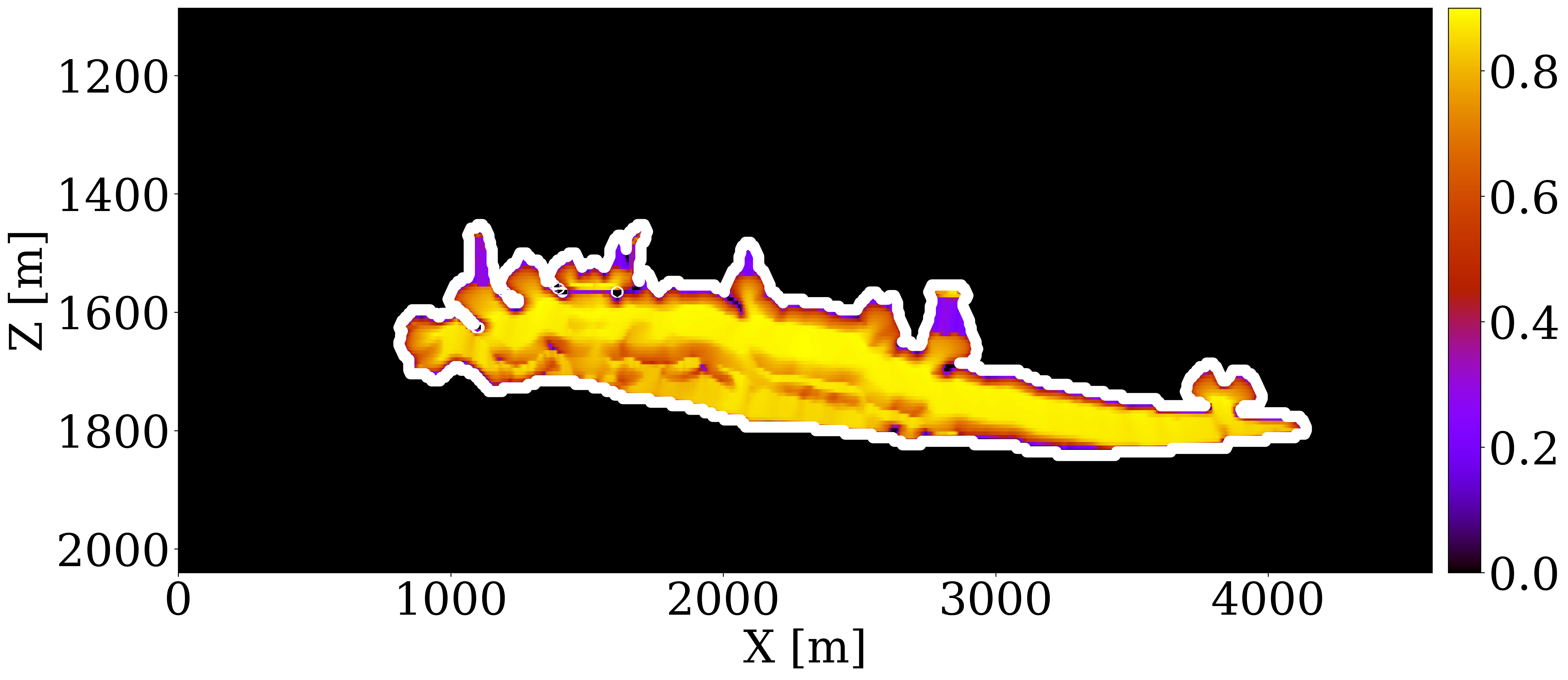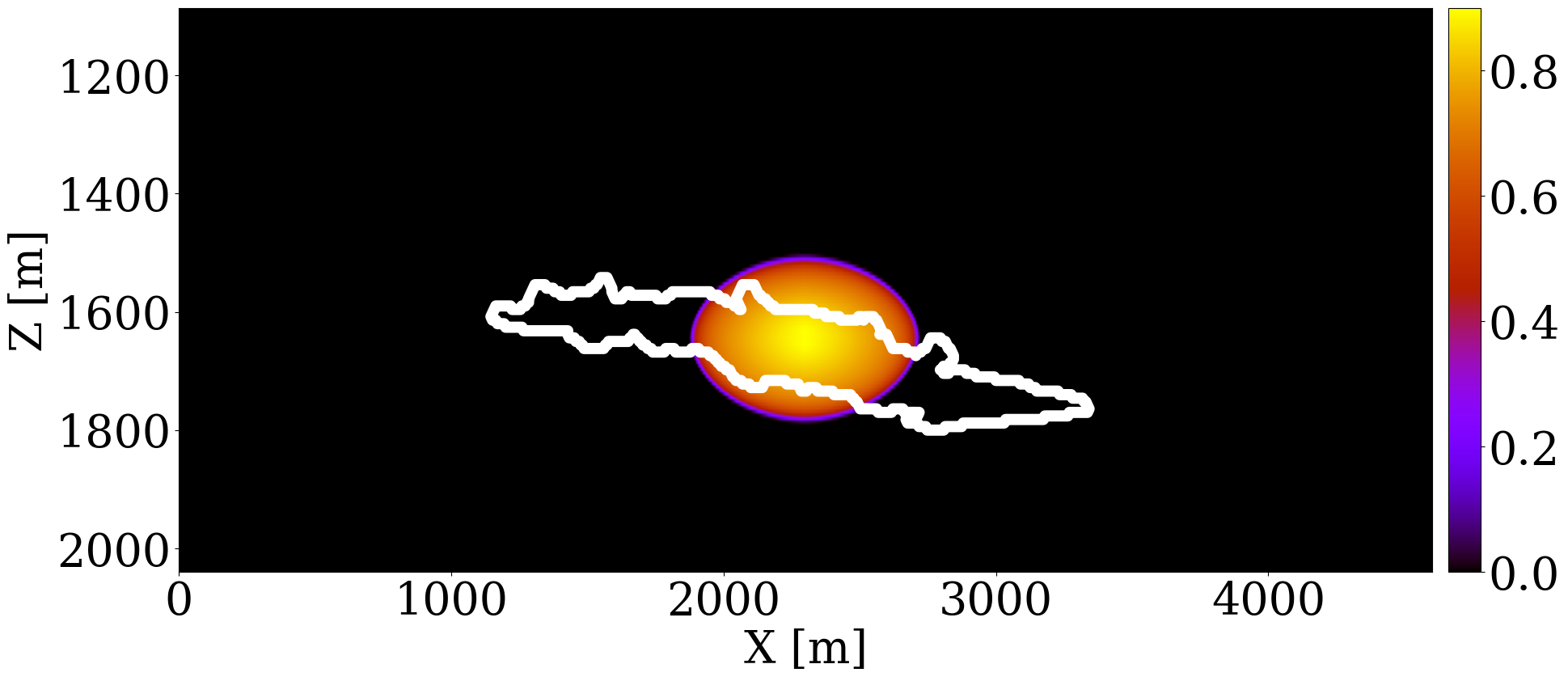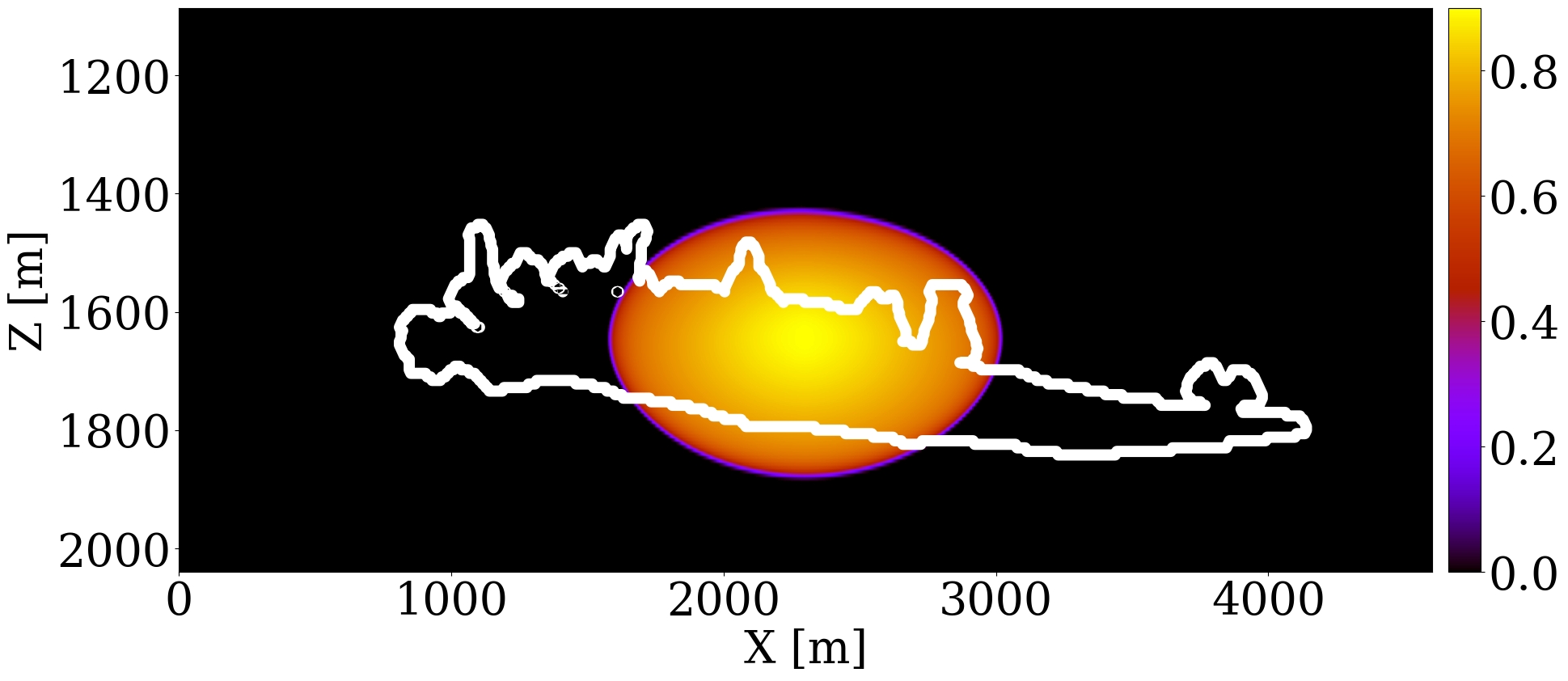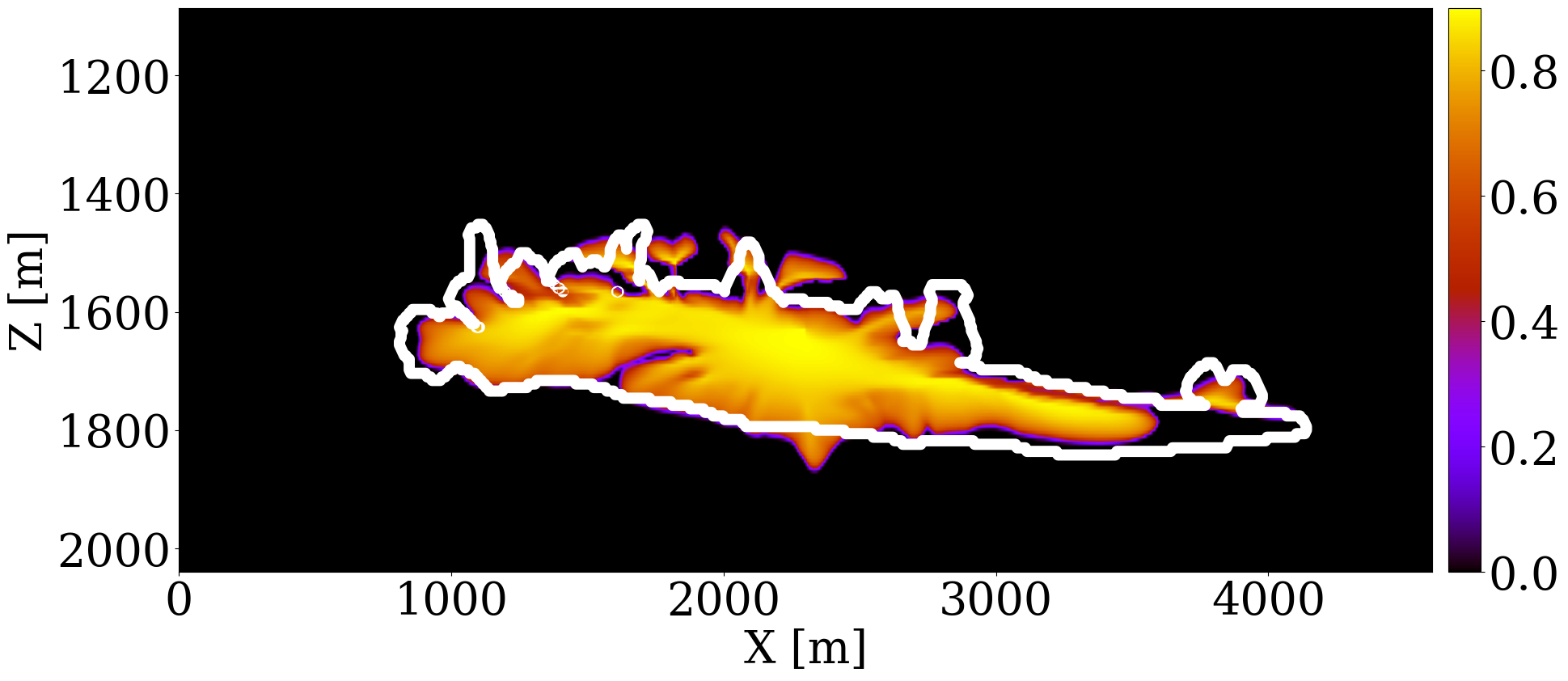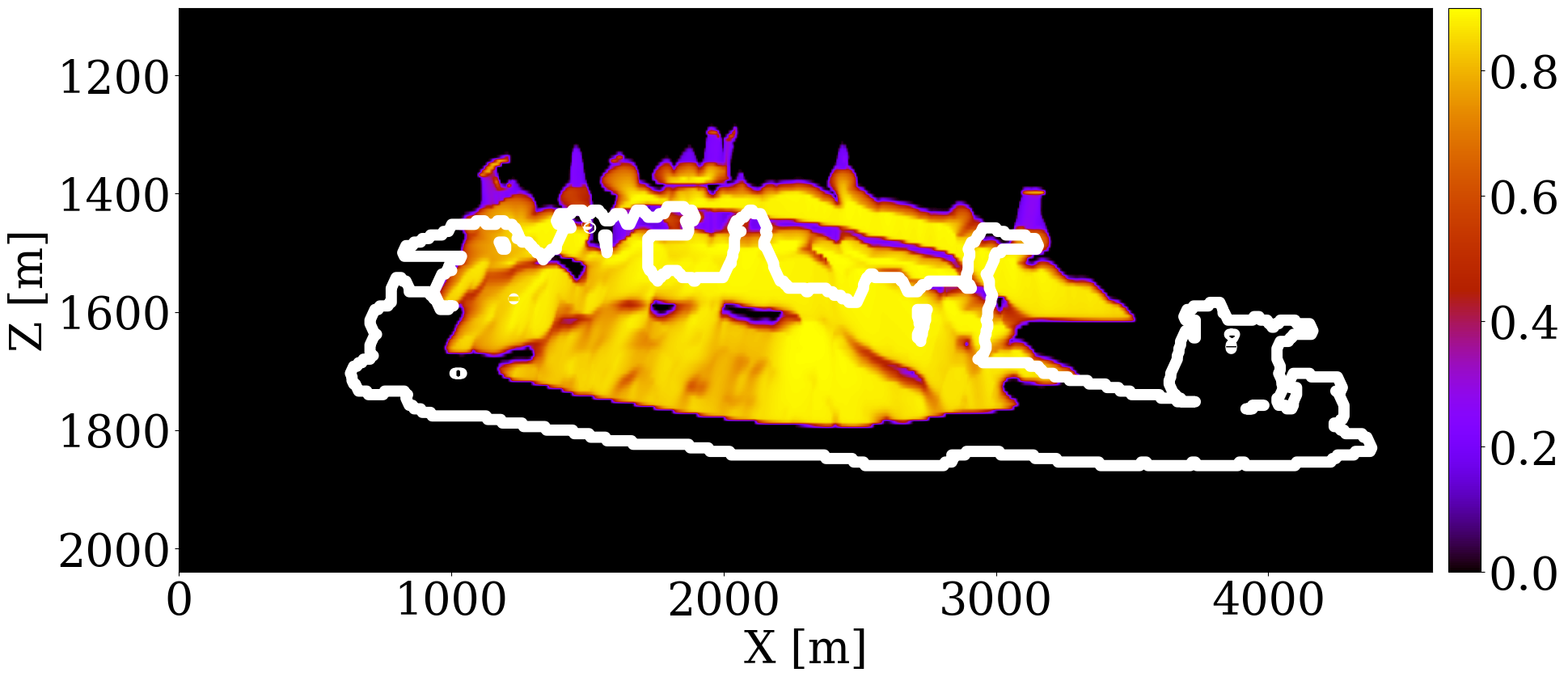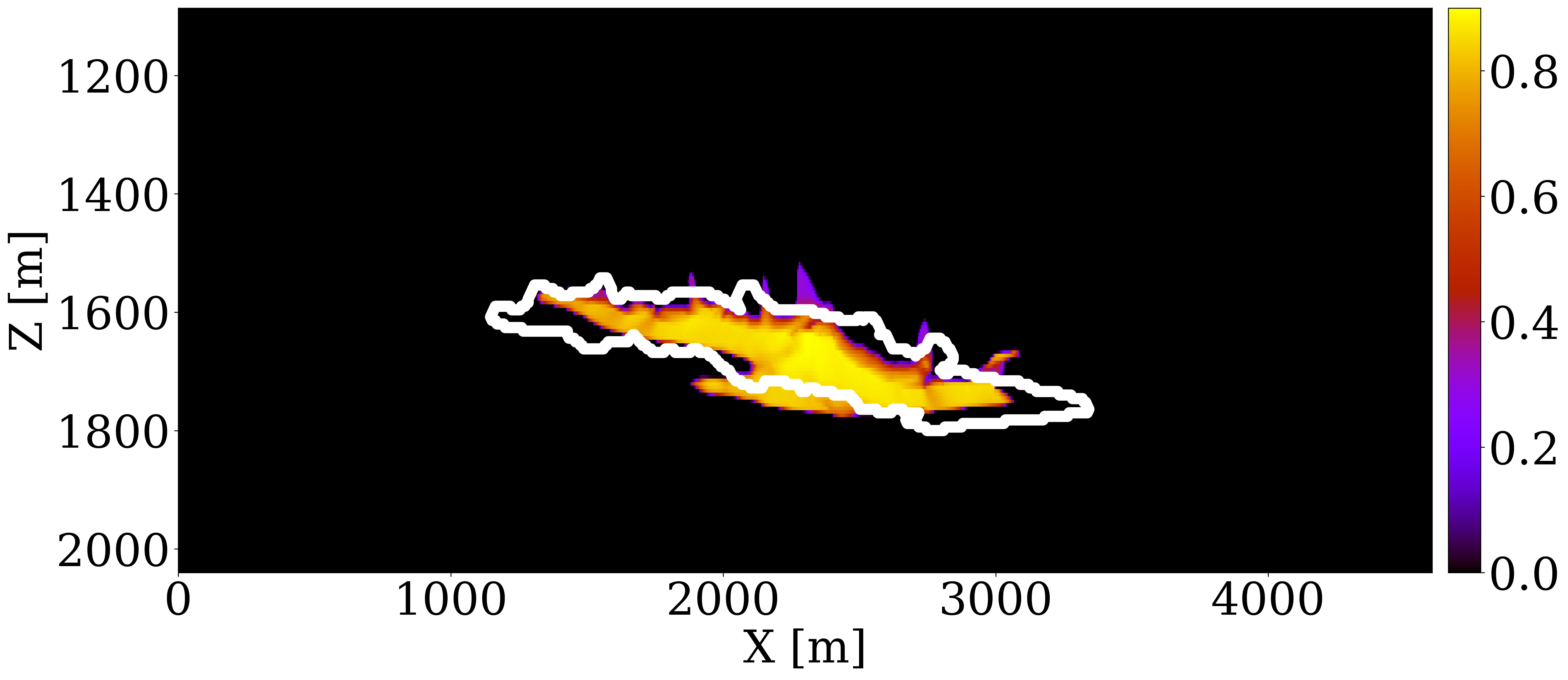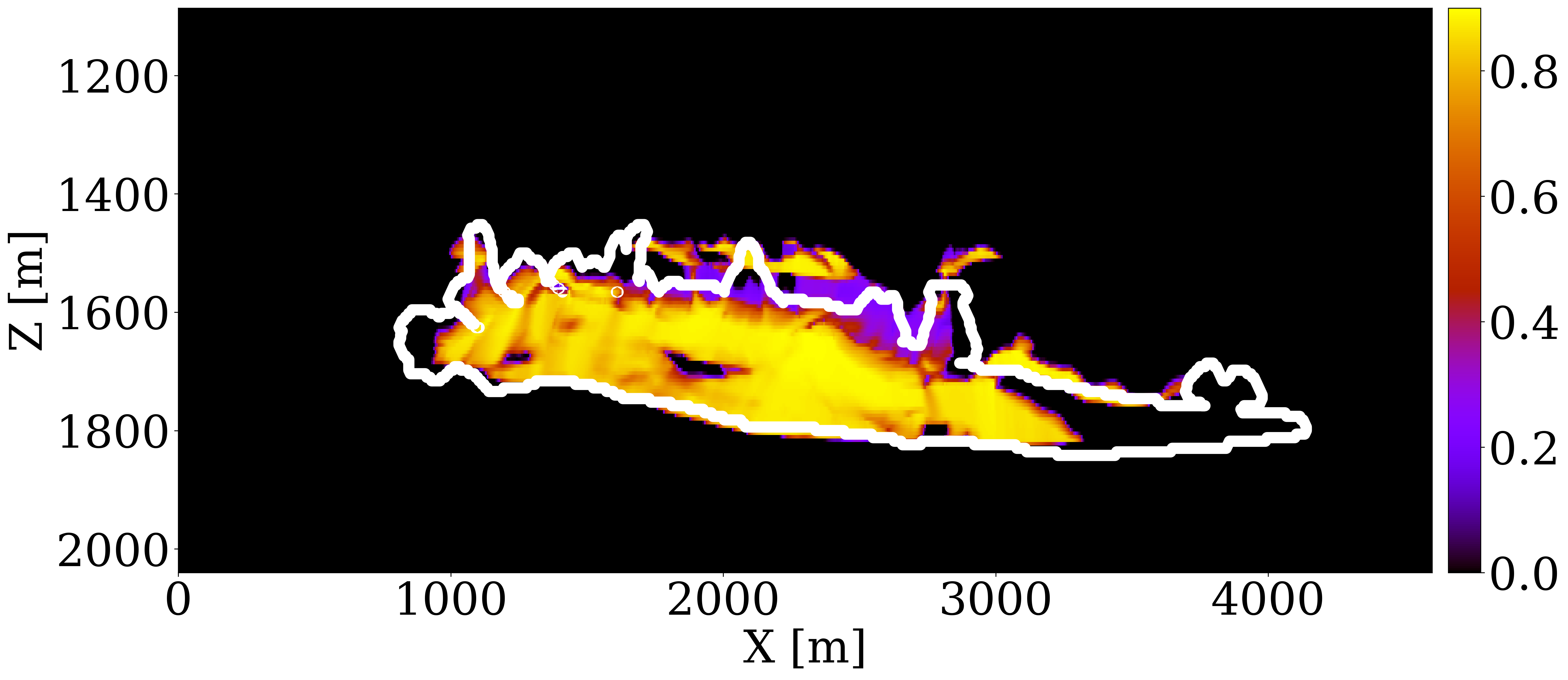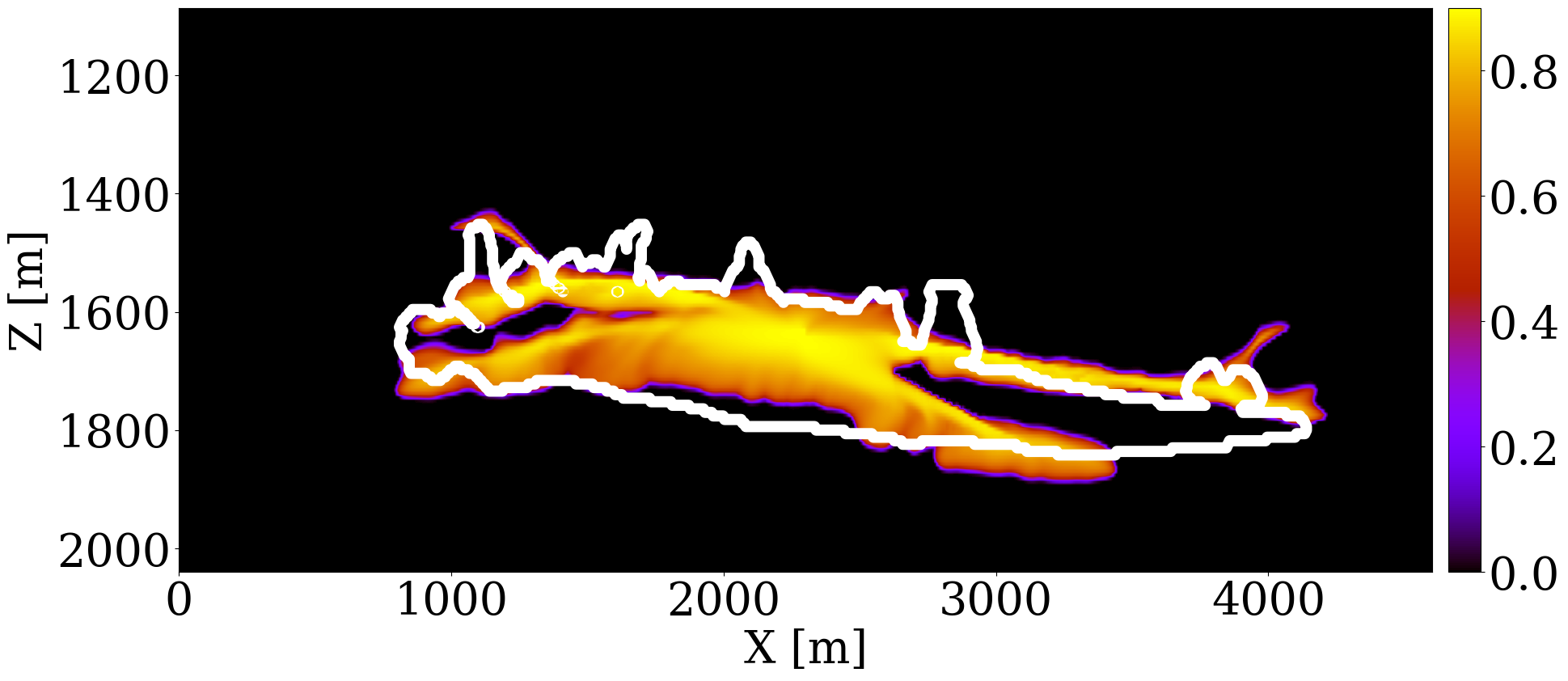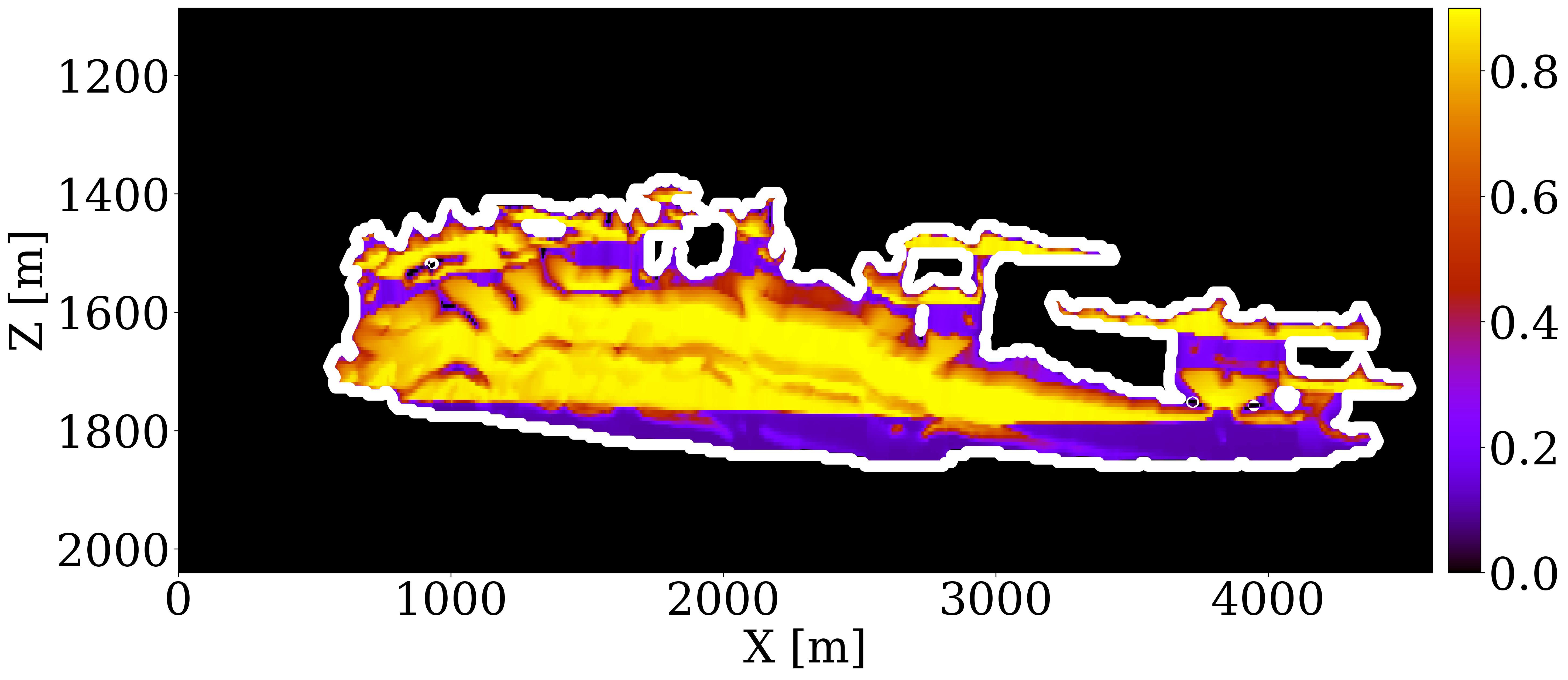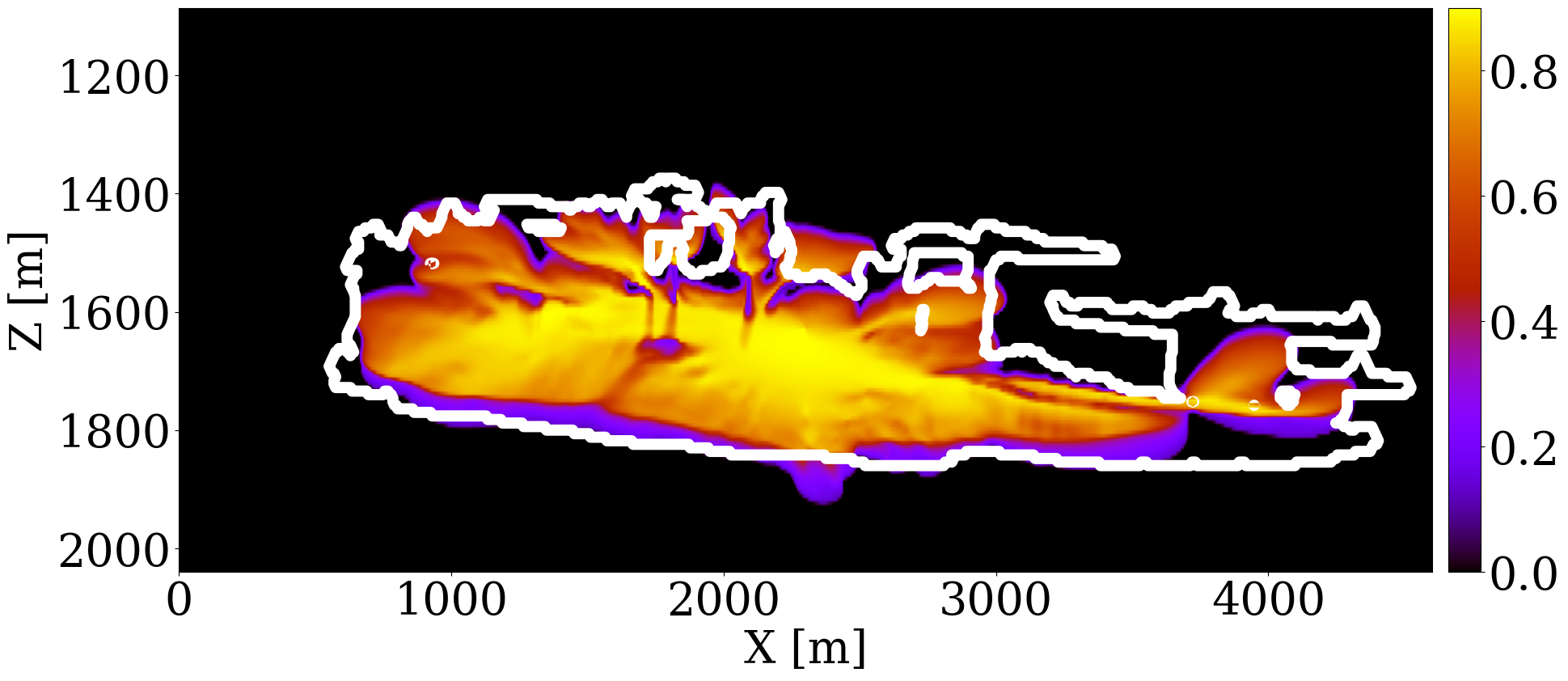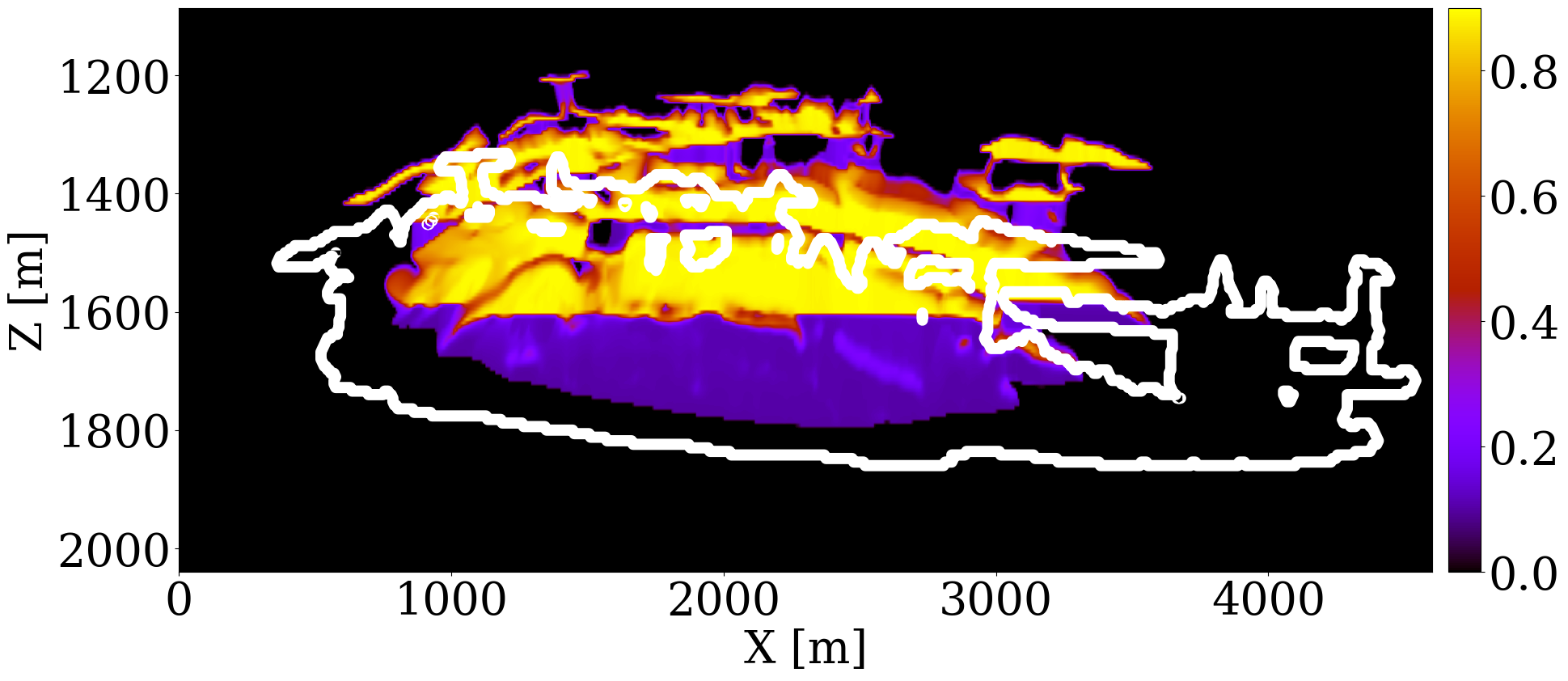Time-lapse full-waveform permeability inversion: a feasibility study
Abstract
Time-lapse seismic monitoring necessitates integrated workflows that combine seismic and reservoir modeling to enhance reservoir property estimation. We present a feasibility study of an end-to-end inversion framework that directly inverts for permeability from prestack time-lapse seismic data. To assess the method’s robustness, we design experiments focusing on its sensitivity to initial models and potential errors in modeling. Our study leverages the Compass model to simulate CO2 storage in saline aquifers, which is derived from well and seismic data from the North Sea, a candidate site for geological carbon storage.
Introduction
Despite significant advancements in reservoir monitoring over recent decades, time-lapse seismic technology continues to grapple with challenges related to cost and efficiency (D. E. Lumley 2001; R. A. Chadwick et al. 2009; A. Chadwick et al. 2010; Furre et al. 2017). Employing 4D seismic workflows, including time-lapse full-waveform inversion (TL-FWI, D. Lumley 2010; Hicks et al. 2016), has become a common practice for estimating changes in the Earth’s elastic properties, facilitating the quantitative interpretation of these changes as indicators of reservoir attributes like fluid content and pressure (Bosch, Mukerji, and Gonzalez 2010; Wei et al. 2017). Recent methodologies aim to leverage time-lapse seismic data for the joint estimation of both elastic and reservoir properties, with a focus on parameters such as saturation and porosity (Bosch et al. 2007; Hu, Grana, and Innanen 2022). However, the integration of seismic imaging workflows with reservoir simulation tools remains limited, constraining the direct application of time-lapse seismic data for permeability estimation or updates. While a few methodologies, such as the approach in Eikrem et al. (2016), offer some integration by using ensemble Kalman filtering to refine permeability and porosity estimates, and Don W. Vasco et al. (2004); D. W. Vasco et al. (2008) have explored using time-lapse seismic data for linearized inversion to update permeability, these efforts represent initial steps toward a more integrated approach.
This paper introduces a novel 4D processing framework for estimating permeability directly from prestack time-lapse seismic data, offering a streamlined, geophysically based inversion process. Unlike traditional methods, this framework, tested in various synthetic case studies (Li et al. 2020; Yin et al. 2022; Louboutin, Yin, et al. 2023; Yin, Orozco, et al. 2023b), updates permeability models by exclusively matching observed time-lapse seismic data. Despite the potential for rapid model updates, initial results have not yet demonstrated significant alterations in fluid saturation predictions, and the resulting permeability models often lack the heterogeneity necessary for detailed analysis. To address these limitations and assess the framework’s real-world applicability for 4D monitoring, we undertake a feasibility study using the Compass model (E. Jones et al. 2012), chosen for its relevance to the North Sea’s geological structures — a region under consideration for CO2 storage. This study evaluates the framework’s sensitivity to different starting models and forward modeling errors, omitting regularization techniques to focus on the impact of seismic data on permeability updates. We explore the framework’s ability to recover fine permeability structures, predict CO2 dynamics within the seismic monitoring period, and forecast CO2 dynamics in near future without any seismic observation. Recognizing the limitations of our simplifying assumptions, we conclude with suggestions for future research to advance this promising field.
Permeability inversion framework
Our feasibility study examines the time-lapse seismic monitoring of CO2 storage, focusing on the integration of three fundamental physics disciplines critical to this process: fluid-flow physics, rock physics, and wave physics, as illustrated in Figure 1. The dynamics of the CO2 plume during injection are modeled using multiphase flow equations (Pruess and Nordbotten 2011), processed through a reservoir simulator (Krogstad et al. 2015; Settgast et al. 2018; Rasmussen et al. 2021; Stacey and Williams 2017). These simulations require detailed inputs, including well operation parameters and the spatial distribution of porosity and permeability, while we particularly focus on permeability, \(\mathbf{K}\), as the parameter of interest in this exposition. The output from the reservoir simulator, \(\mathcal{S}\), primarily the time-evolving fluid saturation of the CO2 plume, \(\mathbf{c}\), serves as the input to the rock physics model, \(\mathcal{R}\). This model translates changes in fluid saturation within the reservoir rocks into variations in compressional wavespeeds, \(\mathbf{v}\), over time (Avseth, Mukerji, and Mavko 2010). Lastly, based on the wavespeed models for each snapshot, the wave modeling operator (Tarantola 1984), \(\mathcal{F}\), is used to generate the time-lapse seismic data, \(\mathbf{d}\), which compiles the seismic data from each vintage.
In practice, the prestack time-lapse seismic dataset, \(\mathbf{d}\), is observed from the field, with the objective being to estimate the past, current, and future dynamics of the CO2 plume in GCS projects. Our methodology diverges from traditional workflows that typically proceed from seismic inversion to quantitative interpretation and subsequent reservoir parameter updates based on the derived wave properties. Instead, we propose an integrated, end-to-end approach that directly inverts for permeability, \(\mathbf{K}\), to reduce the time-lapse seismic data misfit. The core of our method is the composition of three physics-based modeling operators, formulated to minimize the following objective function:
\[\underset{\mathbf{K}}{\operatorname{minimize}} \quad \|\mathcal{F}\circ\mathcal{R}\circ\mathcal{S}(\mathbf{K})-\mathbf{d}\|_2^2.\]
This objective is minimized via an iterative process that includes:
- Generating synthetic time-lapse seismic data using an initial guess for the permeability model;
- Calculating the gradient of the permeability by backpropagating the residuals of the seismic data;
- Updating the permeability model to reduce the misfit between the synthetic and observed time-lapse seismic data.
The advantage of this end-to-end inversion framework lies in its ability to break down silos through multiphysics integration. Specifically, it eliminates the need for intermediate processing steps to update the saturation and wavespeed models. As we demonstrate in the subsequent feasibility study, the inverted permeability can produce more accurate fluid saturation and wavespeed models, leading to a better fit to the observed time-lapse seismic data.
Feasibility study on the Compass model
We evaluates the performance of this inversion framework through a synthetic case study on the Compass model (E. Jones et al. 2012). This model was was derived from well logs and imaged seismic from the North Sea area, which is currently in consideration for GCS projects. We specifically choose this model because it is representative for 4D monitoring of GCS, and also because the grid spacing in this model is \(6\mathrm{m}\) in both horizontal and vertical directions. Conducting a case study in such a fine discretization can demonstrate the efficacy of the end-to-end inversion framework for inverting fine-scale geological structures in the permeability model.
We aim to invert for the spatial distribution of permeability using five vintages of prestack time-lapse seismic data. We utilize a 2D slice of the velocity model, as illustrated in Figure 2 (a), where the red region signifies the storage complex. An artificial proxy permeability model is created to ensure significant permeability contrasts within different layers of the storage complex, with the horizontal permeability displayed in Figure 2 (b). The low permeability layers range from approximately \(10^{-3}\) to \(1\) millidarcies (md), while the high permeability layers vary between \(600\) to \(6000\) md. A CO2 injection well, marked with black \(\times\), is placed centrally to inject supercritical CO2 for 25 years at a constant rate of 2 million metric tons per year. We assume the porosity and the kv/kh ratio are homogeneous and known during inversion, of values 0.25 and 10%, respectively. The simulation of compressible and immiscible two-phase flow, where CO2 displaces brine in porous rocks, is performed using a fully implicit method implemented in JutulDarcy.jl (Møyner and Bruer 2023; Ziyi Yin, Bruer, and Louboutin 2023). The CO2 plume at the 25th year is depicted in grey in Figure 2 (a). After converting CO2 saturation into wavespeed models via the patchy saturation model, we generate acoustic time-lapse seismic data for five vintages at years 5, 10, 15, 20, and 25 using Devito (Louboutin et al. 2019; Luporini et al. 2020) and JUDI.jl (Witte et al. 2019; Louboutin, Witte, et al. 2023), employing a Ricker wavelet with a central frequency of 20 Hz. The source and receiver geometries are shown in Figure 2 (a).
Sensitivity with respect to starting models
To evaluate the efficacy of our end-to-end inversion framework, particularly its sensitivity to initial permeability models, we examine two distinct starting permeability models shown in Figure 3 (a) and Figure 3 (b). The first initial model features homogeneous permeability values (\(100\mathrm{md}\)) across the entire reservoir. This simplistic model serves as a blank canvas, allowing us to explore the extent of permeability updates achievable from a non-informative permeability model. The second scenario introduces a more complex initial model with accurately valued permeability layers that are, however, misplaced due to a distortion, reflecting potential real-world inaccuracies in layer positioning (Bloice, Stocker, and Holzinger 2017). This setup aims to simulate the challenges faced when initial rock type interpretations are incorrect prior to CO2 injection.
In both scenarios, we employ a methodological shortcut often referred to as committing an “inversion crime”, where the data generation and inversion processes share the same computational kernel. This ideal setup is used here to show what is ideally achievable by this inversion framework, with the spatial distribution of horizontal permeability being the sole unknown in our study. To add a layer of realism, we incorporate 8 dB of incoherent band-limited Gaussian noise into the observed data, mirroring the kind of data quality challenges encountered in real seismic datasets.
After 12.5 datapass through the entire time-lapse seismic dataset, we achieve updates in the permeability models, presented in logarithmic scale for both initial scenarios (Figure 3 (e) and Figure 3 (f)). Additionally, Figure 3 (c) and Figure 3 (d) offer a visualization of “ideal” updates by showing the logarithmic differences between the ground truth and the initial permeability models.
The following observations are made: First, the permeability updates are primarily confined to areas directly influenced by the CO2 plume, as delineated by gray curves. This outcome aligns with expectations since the time-lapse variations in wave properties are attributed exclusively to changes in fluid saturation. Consequently, without additional information, this inversion method does not alter permeability values outside the CO2 plume’s extent. Second, the inverted permeability within the CO2 plume largely reflects the trend of the ground truth permeability model. For the scenario with a uniform initial permeability (Case 1), the framework successfully identifies major permeability variations — both high and low (depicted in red and blue, respectively) at approximately \(1600\,\mathrm{m}\) depth — accurately capturing their depth and lateral distribution in alignment with the actual layers. In the scenario involving a distorted initial model (Case 2), the inversion process introduces high-resolution details to the layers affected by the plume, aligning well with the ideal updates shown in Figure 3 (d). Despite these successes, the full magnitude of permeability contrasts is not entirely captured, pointing to the inherently ill-posed nature of permeability inversion (Zhang, Jafarpour, and Li 2014). This limitation highlights the need for comprehensive uncertainty quantification (Gahlot et al. 2023) in future studies to refine the accuracy and reliability of permeability models derived from seismic data.
Sensitivity with respect to forward modeling errors
To extend our investigation beyond the overly idealized scenarios, we next examine the framework’s robustness in scenarios that avoid “committing the inversion crime”. Specifically, this means that the forward modeling kernel used during the inversion process differs from the one used to generate the observed data. A critical area of focus is the potential discrepancies in the brine-filled baseline velocity model before CO2 injection — a common source of error in time-lapse seismic studies. Errors in this baseline model, which feeds into the rock physics model, can produce inaccurate estimated velocity models for CO2-filled reservoir at various stages, leading to inaccuracies in the simulated time-lapse seismic data.
To construct an inaccurate but realistic baseline velocity model, we assume to access to cross-well and reflective seismic data collected at the baseline stage. By applying 10 datapass of FWI on a smoothed velocity model, we obtain the inverted velocity model depicted in Figure 4 (a). This model, albeit imperfect, serves as our baseline for the brine-filled velocity, which is then utilized in the end-to-end inversion framework post-CO2 injection.
For this phase of the study, we employ the initial permeability model from Figure 3 (a) to assess the impact of modeling errors on the inversion results. The update to the permeability, shown in logarithmic scale in Figure 4 (b), reveals some artifacts outside the CO2 plume area due to the modeling inaccuracies. Additionally, a high permeability zone within the plume is slightly misplaced when compared to the updates in Figure 3 (e), yet the overall trend of permeability changes is correctly captured.
Following this permeability update, we proceed with reservoir simulations using the updated permeability models to assess the corrections made to the CO2 plume predictions. This step is crucial for validating the practical utility of the inversion framework for real-world seismic monitoring scenarios.
CO2 plume estimation and forecast
The primary objective of our end-to-end inversion framework is to accurately estimate reservoir permeability, a crucial step towards the ultimate goal of predicting CO2 saturation both historically and in the near future for effective GCS monitoring. To validate the framework’s efficacy, we conduct a quality control comparison involving CO2 saturation simulations based on initial, inverted, and ground truth permeability models, as depicted in Figure 5. Across all simulations, we note substantial improvements in the CO2 plume shape predictions, closely aligning with the boundaries of the ground truth CO2 plume. Notably, the initial simulations significantly misjudged the lateral spread of the CO2 plume. The corrections applied through the updated permeability models, however, yield accurate representations of the plume’s lateral extent.
Expanding our analysis to future forecasting, Figure 6 illustrates the predicted movement of the CO2 plume over a 40-year period following a 25-year injection phase, without further CO2 injection or seismic observations. During this forecasted period, the CO2 plume primarily ascends due to buoyancy, while a portion (approximately 10%) remains trapped in the pore spaces, indicated in purple. This phenomenon, known as residual trapping (Rahman et al. 2016), is a critical factor in assessing the long-term storage capabilities of GCS projects. Initial forecasts tended to underestimate the extent of CO2 sequestration through residual trapping. In contrast, simulations driven by the updated permeability models not only provide a more accurate estimation of the permanently stored CO2 volume but also closely match the ground truth CO2 plume’s boundaries, even without any further monitoring data.
These findings underscore the potential of the permeability inversion framework not only in refining current CO2 plume delineations but also in offering reliable predictions for future plume behavior. Such predictive accuracy is invaluable for GCS project managers and practitioners, enabling informed decision-making regarding well control adjustments or intervention strategies to optimize long-term CO2 storage safety and efficiency, as highlighted by recent studies in the field (Ringrose 2020).
Limitations
While our case studies offer promising insights, it’s crucial to acknowledge the assumptions underpinning our approach and recognize the inherent limitations that merit further investigation. Additionally, we explore the potential for integrating this 4D processing workflow with other reservoir characterization and management strategies.
Reservoir simulation
Our study assumes known values for all multiphase flow model parameters except permeability with a known relationship between horizontal and vertical permeability. Other parameters that include significant rock-dependent variation include porosity, relative permeability functions, residual water saturation, temperature and capillary pressure were kept constant in the simulations to isolate the impact of permeability on seismic data. In practice, a multi-parameter inversion, potentially incorporating constraints like the Kozeny-Carman relationship (Costa 2006), could offer a more holistic view by jointly inverting for porosity and permeability. In addition, our assumption that supercritical CO2 miscibility in the resident brine is low could be removed by considering a compositional flow model that introduces additional uncertain parameters. The feasibility of such approaches hinges on the availability of a differentiable reservoir simulator, like JutulDarcy.jl, or the use of deep neural networks to approximate the physics of multiphase flow (Grady et al. 2023; Louboutin, Yin, et al. 2023; Yin, Orozco, et al. 2023b) and serve as a surrogate during inversion. Moreover, the simplistic assumption of adherence to multiphase flow equations may not hold in scenarios involving CO2 leakage, necessitating robust leakage detection methodologies (Erdinc et al. 2022; Yin, Erdinc, et al. 2023).
Rock physics
The case studies currently ignore the pressure effect on the wave properties (MacBeth 2004; MacBeth, Floricich, and Soldo 2006). While this can be justified for some GCS projects where the pressure change is relatively subtle, the inversion framework can be extended to honor the relationship between pressure and wave properties. The patchy saturation model employed may also not fully capture the complexities of real-world reservoirs, indicating a need for calibration of the rock physics model against actual reservoir and seismic data.
Wave physics
The omission of updates to the brine-filled baseline velocity model represents a simplification that warrants further exploration. Future research could extend the framework to jointly update this baseline alongside permeability, incorporating additional parameters like shear wavespeed and density. Quantifying uncertainties in velocity (Yin, Orozco, et al. 2023a) and permeability models remains a critical challenge for enhancing the reliability of inversion results.
Discussion and conclusion
This feasibility study, centered on the Compass model, elucidates the inversion framework’s capacity to refine permeability estimation, offering high-resolution spatial insights that complement traditional well measurements. Despite the limitations related to recovery perfection and the reliance on initial models, the permeability updates within the CO2 plume region deliver actionable intelligence for reservoir modelers, potentially reducing the cycle time in 4D processing workflows.
Crucially, our study underscores the untapped potential of time-lapse seismic data in reservoir permeability updates, bridging the gap between seismic data and permeability through a novel end-to-end inversion approach. While acknowledging the necessity for further validation before field application, we posit that the integration of multiple physical disciplines heralds a promising future for addressing the complexities of time-lapse reservoir monitoring.
Embracing this multiphysics approach edges us closer to realizing a digital twin for subsurface reservoir monitoring and management (Herrmann 2023), highlighting the transformative potential of such integrative methodologies in enhancing the precision and efficiency of reservoir characterization and decision-making processes.
Acknowledgement
The authors gratefully acknowledge the contribution of OpenAI’s ChatGPT for refining sentence structure and enhancing the overall readability of this manuscript. This research was carried out with the support of Georgia Research Alliance and partners of the ML4Seismic Center. This research was also supported in part by the US National Science Foundation grant OAC 2203821.



